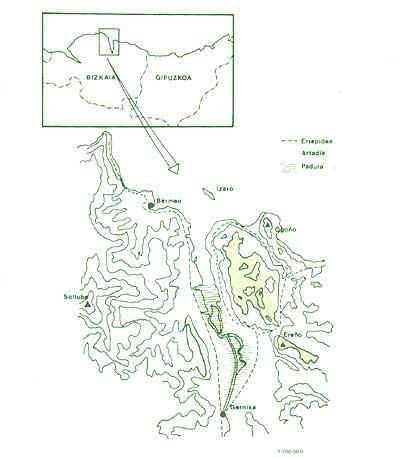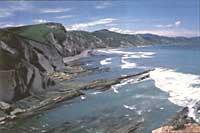Surroundings of Gorliz: Corner of the Basque Country
1990/12/01 Ekolan Iturria: Elhuyar aldizkaria
The municipality of Gorliz is located in the Vizcaine region of Uribe-Kosta from Bilbao to the Northeast. The beauty and breadth of its beach has made Gorliz an important tourist centre. This municipality offers naturalist visitors many interesting options throughout the year. In winter you can enjoy a landscape formed by thick cliffs of the Cabo de Villano; of a florida countryside of Mount Ermua in spring; of a blind forest of Astondo in summer, or of some dunes near the beach, and of a walk in autumn to the Castle of Butrón, where the leaves of the forest give a fascinating color to the tour.
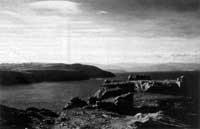
Despite the strong human pressure in the area, aquatic and terrestrial ecosystems with a wide variety of flora and fauna are preserved. For example, dunes, cliff, Cantabrian oak, marsh, mixed forest and coastal ecosystems.
The first, in the vicinity of the Gorliz Hospital, is divided by succession of dunes in two zones: one fixed in maritime pine (Pinus pinaster ssp maritima), French pile (Tamarix gallica) and other community species (Oenothera biennis) and armoury (Eryngium campestre). Among other species, closer to the sea, of mobile character, are the Marina (Eryngium maritimum), the Lilip de mar (Pancratium maritimum), the Gramínea Festuca juncifolia, the Esnebelar marino (Euphorbia paralias) and the Post-Arenal that colonizes sands very close to the sea, the Amophila arengramínea.
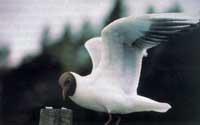
Also, along the route of Cape Billano, the cliffs of the coast from Astondo to Landaluze, in addition to offering an attractive maritime show, have numerous species of own plants, such as the slopes of these cliffs, the heliophyll crack (Pteridium aquilinum) and the eel (Erica vagans) and the common coastal heath (Genovino). When the land is somewhat more acidic, other species such as the otea (Ulex europaeus), the common eel (Calluna vulgaris) and the purple eel (Erica cinera) will appear. At the foot of the cliff we find the species that best adapt to the variation of salinity: The Festuca rubra grass, the plant (Plantago maritima), etc...
In these cliffs we can observe one of the most unique geological formations, the black Flysch. This, formed by layers of lutitas, sandstone and conglomerate, arises in the deep submarine environment. On the other hand, in the streets of the cliff you can see coastal marine birds such as the large cormorant (Phalacrocorax carbo), moñudo cormorant (Phalacrocorax austotelis), common tern (Sterna hirundo), argéntea gull (Larus argentatus), gull and reidora (Larus diribundus).
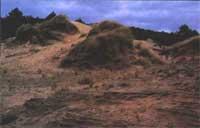
In Astondo and in the bushes of Cape Billano and Mount Ermua we have the Calcícola Holm oak of the Cantabrian. For some time, due to the decline suffered by logging and coal exploitation, the formation of a dense and compact forest structure, these dark green areas have a spectacular botanical, faunalistic and landscape value. The species characteristic of this community are:
- Holm oak (Quercus ilex), evergreen, leafy and tall tree, which can reach 20 m, although often found in the form of a bush. Its leaves are dark green and changing.
- Madroño (Arbutus unedo), a tree of white flowers that extend in autumn. As the fruits ripen from yellow to bright red, they can be eaten but are not of good taste.
- Endalaharra (Smilax aspera) is a climbing plant of thorns with white-yellowish flowers and black or red fruits that can reach a height of 15 m.
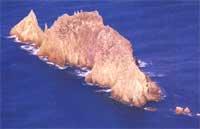
Other species of this association of shrub stelae that delimit the surrounding meadows, such as the bushes (Phyllirea latifolia), the chorizos (Ramnus alaternus), the arcas (Rosa serpenvivens), the ruscos (Ruscus aculeatus), the jureles (Lentiscus alares, etc. ), and its distribution could be much larger. For centuries these forests have been exploited mainly for wood, so these are master or degraded bushes that are currently scattered through the landscape of Gorliz. However, these forests are important because they protect and improve the pavement.
The marsh (in the estuary of Plentzia, near the neighborhood of Gandia, in Junquera) is composed of species adapted to the high salinity and periodic rafts. Thanks to the association of plants of this ecosystem, we can observe in this habitat a large number of waterbirds. For example: royal heron (Ardea cinerea), small heron (Egretta garzetta), common correlims (Calidris alpina), argéntea gull (Larus argentatus), etc... This marsh, although of little width, is very well preserved. In the places most affected by the sea tide the Spartina maritima grass extends.
Due to its extensive expansion, the almost shrubby halophyte areas stand out. This association, located on the first line on the level of the pleamar, has as characteristic species the marine vegetable (Halimione portulacoides). Other auxiliary species are salty grass (Salicornia ramosissima), Inula erithmoides compound, Sarcocornia fructicosa kenopodicea, etc. At the rear, in the areas of occasional stagnation of the tide, a new sawmill is formed (with predominance of the reeds) and in the areas where the water level drops you can see the French pile (Tamarix gallica).
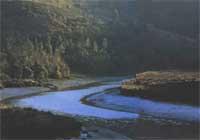
On the other hand, the riverside forest, dominated by the alder, forms gallery structures in some areas of the Butrón River. You can still see unique species of the river ecosystem.
For example: alder (Alnus glutinosa), willow (Salix atrocinerea), urritza (Corylus avellana)... Other species present in the shrubby and herbaceous strata are: The flower of St. Joseph (Primula elatior), the snake grass (Arum italicum), the gold button (Ranunculus repens), the sword grass (Carex pendula), the fox tail (Equisetum sp), the endalaharra (Smilax aspera)... We can also see birds related to this medium: Gallinula chloropus, of black plumage, with a reddish on the beak; Martín pescador (Alcedo athis), small bird of long beak, of blue and orange color; very shy and under the water, small hold under the water (Podicepis, motilcólica collica). Among the amphibians are the common frog (Frog perezi), the common toad (Bufo bufo) and the Iberian txantxiku (Alytes obstreticans). We can also find reptiles such as culebra corbatana (Natrix natrix) and culebra or curved snake (Natrix maura).
The curved snake is an 80 cm long water ofide. When it feels attacked, the body threatens with an "S", treading the head, triangulating and producing in passing an aromatic smell and blowing, so it adopts the behavior of the eve. However, it is completely safe.
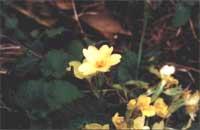
Finally, on the slopes that surround the Butrón River, the different ecosystems give rise to typical plant species of basic substrates and slightly acidic eutrophic pavements. These species belong to the mixed forest ecosystem, in which limestone oak predominates (Quercus robur). Other auxiliary species are ash (Fraxinus excelsior) and chestnut (Castanea sativa), golden (Coryllus avellana), maple (Acer campestre), etc. Other species present in the shrub layer are the red cornice (Cornus sanguinea), the white hawthorn (Crataegus monogyna), etc. And in the grass layer: Ferns Polysticarto setiferum and Dryopteris affinis, broom (Ruscus aculeatus), violet (Viola sylvestris), golden button (Ranunculus nemorosus), etc. Unfortunately, in Gorliz, as in other parts of the Basque Country, these ecosystems have been replaced by pines and eucalyptus trees.
Finally, the tour will end in the forest fields located in the area of Butrón Castle. The building that we can see today, promoted by the Marquis of Torrecilla, descendant of the lords of Butrón, was built by the Marquis of Cuba in the nineteenth century. Where at the end of the twentieth century was the tower house of the lords of Butron (VII. of the century). A tower of the ancient wall is still preserved. This romantic castle, foreign to the old tower house, is of neo-Gothic style very appreciated at that time. In the spectacular garden that surrounds the castle are mixed gallant trees from abroad (cedar, magnolia, cypress, palm...) with native species (oak, yew, chestnut, ash, alder, etc. ).

Gai honi buruzko eduki gehiago
Elhuyarrek garatutako teknologia




